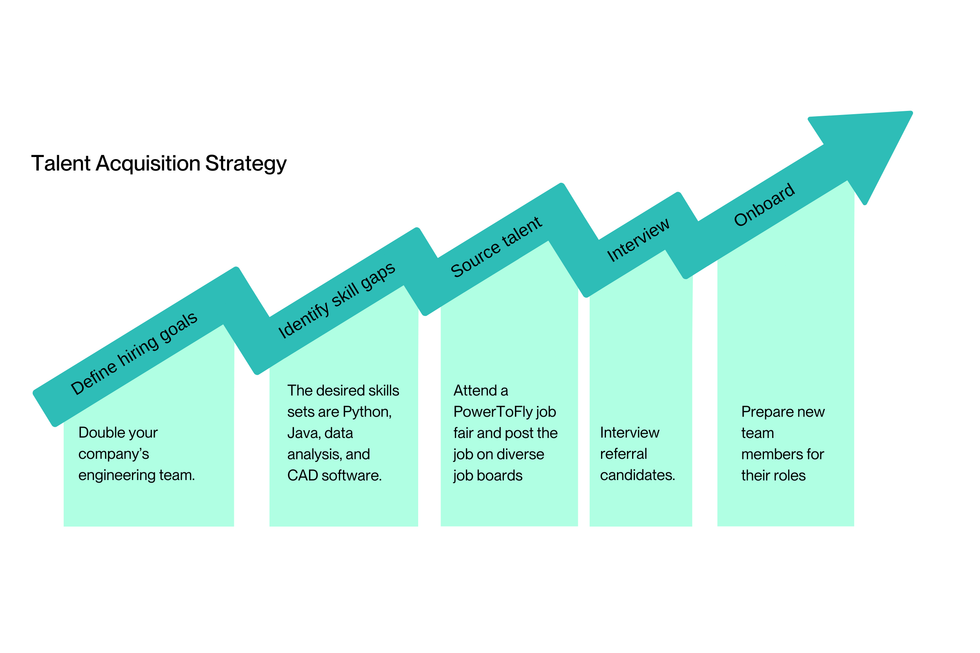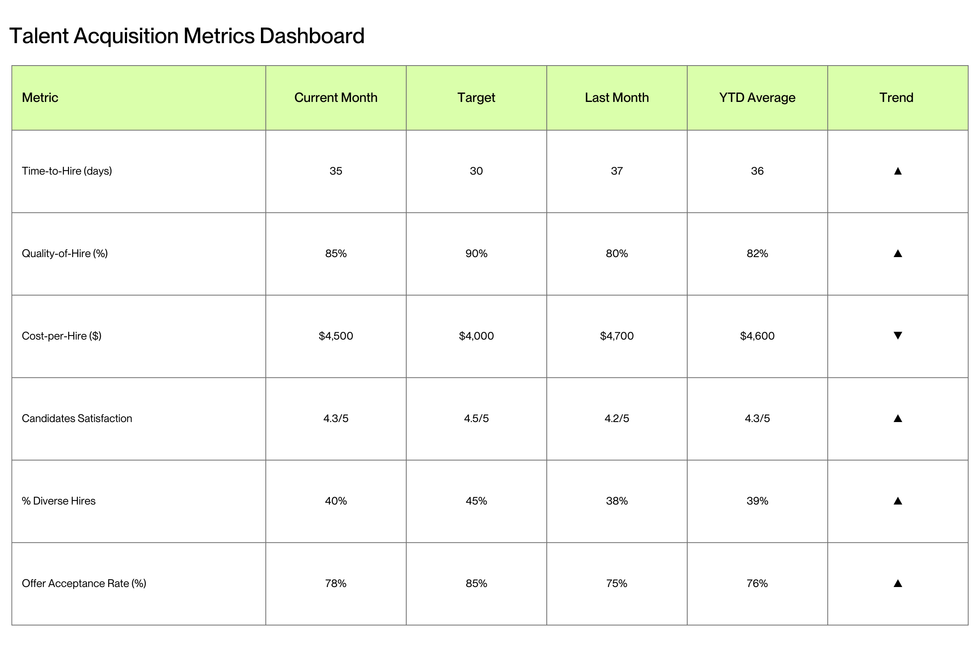In the world of recruitment, staying ahead requires embracing change with gusto and thinking proactively. Trends like skills-based hiring and lean team-building are continuing to grow more popular, so organizations must emphasize forward-thinking talent acquisition strategies in order to attract, recruit, and retain the finest talent.
What goes into a talent acquisition strategy, and why is it important?
When we talk about a talent acquisition strategy in this blog, we’re going to be talking about the systematic approach to sourcing, attracting, and hiring top talent while aligning your hiring goals with the business goals.
Unlike reactive hiring methods, talent acquisition strategies are proactive, with an emphasis on developing a strong talent pipeline, nurturing applicants, and supporting long-term organizational goals. A well-crafted plan is critical for firms trying to hire the right talent to accomplish their targets while also encouraging innovation and growth.
Read this next: Talent acquisition - What is it and how to do it inclusively
Should recruiting be paying attention to trends?
Yes! Looking ahead to 2025, we’re definitely seeing the talent market influenced by several transformative trends you should look at, including:
Skills-based hiring will outpace degree-based requirements: As industries prioritize practical ability above formal qualification, skills-based hiring will become the dominant talent acquisition strategy. Companies such as Google and Apple, for example, have already eliminated degree requirements for many positions, instead focusing on individuals' demonstrated expertise and performance in skill evaluations. This trend allows organizations to tap into a larger talent pool, encouraging diversity and innovation while addressing significant skill shortages in fields such as technology, healthcare, and engineering. It also tends to encourage better retention and lower churn!
Watch this next: The skills-based revolution
Remote and hybrid-first hiring will continue to dominate: Candidates and employers value the flexibility provided by remote and hybrid work models. Beyond the inherent lifestyle options this allows, remote and hybrid work arrangements provide access to talent pools far outside their headquartered cities, allowing companies to hire the best candidates regardless of location. To thrive with this model, businesses must invest in digital collaboration tools, clear remote work regulations, and training programs that keep staff productive and engaged regardless of their physical proximity.
Read this next: 10 lessons on continually evolving your business for 2025
Inclusive workplaces will win over candidates: Not just a buzzword; candidates are looking for companies with strong diversity, equity, inclusion, and belonging (DEIB) programs and inclusive company cultures. Companies with more inclusive atmospheres enjoy some very real benefits such as higher employee retention, improved team performance, and increased innovation. To attract (and keep!) top talent, organizations must go beyond surface-level DEIB commitments and provide genuine perks such as maternity leave policy, mental health support, anti-bias training, and additional accessibility accommodations.
Read this next: The DEIB-backed employee benefits candidates expect to see in 2025
For even on what’s trending for the upcoming year, check out: New talent acquisition trends to watch in 2025
Step-by-step guide to build your talent acquisition strategy
1. Define your hiring goals
The very first step in developing an effective talent acquisition strategy is to establish your specific, measurable hiring targets (KPIs, etc.). Your goals should be in line with your company's overall objectives and ideally anticipate future employment requirements whenever possible.
Examples of hiring goals might include:
- Reducing the time-to-hire for vital roles by 20%.
- Increasing the percentage of diverse hires by 10%.
- Cultivating candidate satisfaction scores to 4.5/5.
Read this next: Maximize your workforce with high-performing teams
2. Build a candidate persona based on the skills for the job
To bring in the right talent, it helps to know what an ideal candidate looks like (on paper, not literally). However, be careful because focusing entirely on stringent prerequisites such as degrees or even years of experience in that job title/industry/etc., might limit diversity. Instead, build a candidate persona that highlights the role's required skills, talents, and traits.
Example: Instead of demanding a specific degree or five years of experience, a marketing manager can prioritize talents such as content strategy, data analysis, and leadership.
Read this next: Skills-based hiring for a more inclusive workforce
3. Optimize your employer brand
Your employer brand is simply your company's reputation in the workplace. Naturally, a strong, authentic employer brand can attract top talent and differentiate you from competition. Consider using employee testimonials, underlining business values, and emphasizing career growth prospects in your branding efforts.
Read this next: 10 employer brand mistakes (and solutions) for 2025
4. Tap into diverse communities
Sourcing candidates from various communities is an important part of modern talent acquisition strategy! Forging partnerships with organizations that promote underrepresented groups, attending diversity-focused job fairs, and utilizing online platforms are all excellent strategies to broaden your reach. Traditional hiring can be fairly exclusionary, so go grab some talent that’s historically been on the sidelines!
Psst... wondering how? Meet PowerPro, your platform for in-depth recruitment funnel data and insights. PowerPro’s dashboard gives you instant access to actionable recruiting insights and the performance metrics you need to hit your DEIB goals.
Contact our team to learn how PowerPro can help you transform diversity, equity, inclusion, and belonging (DEIB) in your workplace.
Read this next: 16 best talent acquisition softwares
5. Leverage employee referrals
Employee referrals can be a powerful tool for locating qualified candidates. To encourage referrals, design programs that reward employees for proposing candidates who meet your company's goals and values. Clear standards and incentives can boost participation and help you develop a strong talent pipeline. Don’t ignore qualifications and skills though!
Read this next: 7 chat & learns to elevate your hiring game
6. Use data to drive decisions
Data-driven hiring is a great way to optimize your talent acquisition strategy. Software tools like dashboards with clear metrics and tracking can help you understand key performance indicators (KPIs) such as time-to-hire, cost-per-hire, and quality-of-hire.
For example:
Read this next: The future of AI recruiting: What to know as an employer
7. Invest in the candidate recruitment experience
The candidate experience can absolutely make or break your talent acquisition strategy and since onboarding doesn’t end after an offer letter, it can affect turnover as well! To provide a positive experience:
- Communicate transparently throughout the hiring process.
- Streamline application procedures.
- Personalize interview interactions.
Read this next: How to recruit candidates with DEIB in mind
8. Build an inclusive onboarding process for new hires
Like in the previous step, an inclusive onboarding procedure is vital for preparing new hires for continued success. This involves making training materials more accessible, designating mentors, and building relationships with diverse teams.
Read this next: 7 steps for inclusive remote onboarding
Assemble your talent acquisition strategy
Honestly, we feel like crafting an effective talent acquisition strategy is not really an option; it’s a must-have for businesses seeking to remain competitive in this already competitive talent market. You can recruit and retain top talent while creating a more inclusive workplace by defining your hiring goals, focusing on skills-based hiring, enhancing your employer brand, and making data-driven decisions.
Consider this your call to action to think beyond traditional hiring practices and embrace strategies that prioritize innovation, diversity, and inclusion! With these tools and insights, your business can face the challenges of 2025 while emerging stronger, more agile, and better prepared for the future of work.







